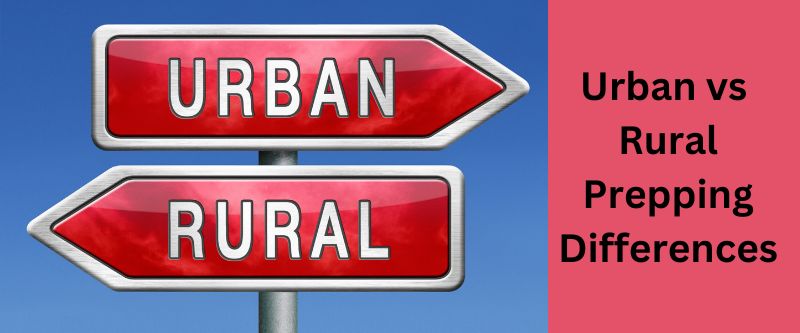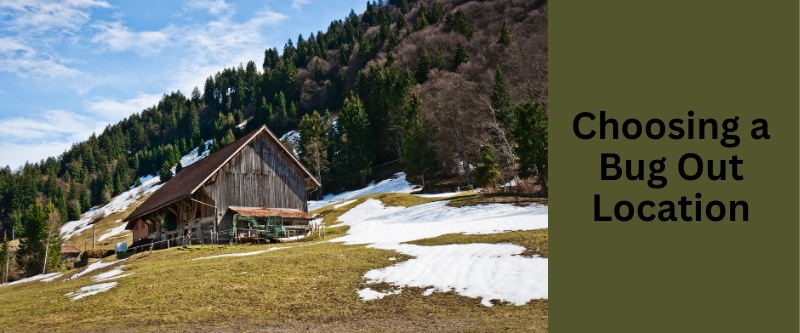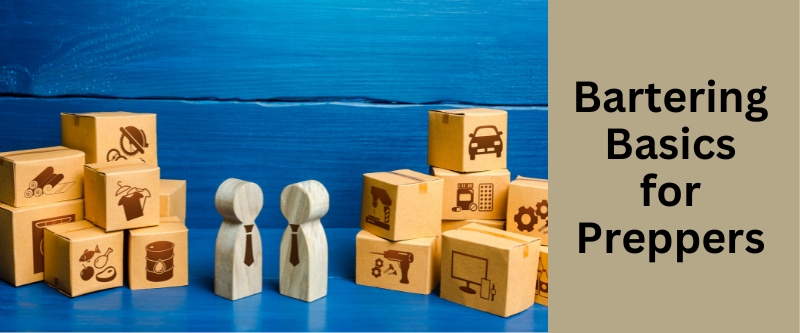Table of Contents
The differences between urban and rural prepping range from fundamental to superficial, depending on the risk assessment.
Extreme SHTF Scenario
Let’s posit the extreme SHTF scenario of an EMP event that disables all unhardened electronically controlled systems. And let’s compare the effects on urban and rural living.
Urban Effect
A big city becomes untenable almost immediately. The elevators don’t work, the subway systems don’t work, the traffic lights don’t work, the gas pumps don’t work, the water supply systems go down. And so on.
In that circumstance, panic ensues and there is a mass attempted exodus on foot or in automobiles limited in range to whatever is in their tank. In the meantime people will be looting the stores for food. There will be inevitable loss of life.
The urban prepper has no choice but to hunker down in his apartment with whatever water and food there is on hand and to wait things out. To make things worse, in an urban setting there is not much space for food and water storage in the first place.
And on top of that, the toilets don’t flush.any anymore, making a small apartment pretty much unlivable very fast.
Rural Effect
The rural prepper is faced with similar electrical systems failures. So the power will go out and the water won’t come out of the faucets. But, because of the rural setting, he is much better insulated from the effect.
This is because of isolation from a mass of panicked people. Plus he will be much better supplied with food and water, assuming he has taken advantage of the greater storage space available to him.
And human waste disposal is dealt with by resorting to an old style outhouse.Also the rural prepper, as distinct from the city apartment dweller, is in a better position to protect himself from an EMP event with an EMP Shield, in conjunction with his off-grid solar power and wind generator.
Fundamental Difference
The bottom line distinction is that, in a sense, the rural prepper is already bugged out. And, in the extreme circumstance posited, the opportunity for the urban prepper to bug out is very limited. And were he to venture forth with his trusty bug-out bag on his back, he risks getting killed for it.
On the other hand, it can certainly be said that the urban prepper is at no risk from a catastrophic wildfire!
Risk/Benefit Assessment
Each prepper must make his own risk/benefit assessment. And there is a lot to be said for city living. Not least of these is that the need to make a living makes it necessary to live in the city or at least a suburban area of the city.
So there are trade-offs to be made. However, in our opinion anyway, the rural prepper is in a fundamentally safer position than the urban prepper.
But let’s get into the general differences between urban and rural prepping.The situation of the suburban prepper is somewhere in between. Understanding the differences is the key to assessing risk.
Here is one person’s take:
Urban vs. Rural Prepping: The Basics
In the world of prepping, you have got to understand your environment. Whether you’re in the heart of a bustling city or in the serenity of the countryside, each setting presents its unique pros and cons.
Implications of Population Density
Urban areas are characterized by their high population density. On the one hand this means that if you are in an urban environment, you have greater and readier access to the necessities of life than you have in a rural area.
This reality imbues the lifestyle. For example, the urban dweller tends to have a “just in time” attitude to having food on the table. He may well just run down to the corner store for what he wants to eat that evening.
By contrast, the rural dweller likely has a two week supply of food on hand, evejn if he isn’t a prepper.
So, in the SHTF situation, the impact on the urban dweller is immediate and pressing. You suddenly have a lot of people competing for the same resources. .
Community Cohesion
Because of the population density of the urban environment, the infrastructure is also denser. And this means that in the city there are community resources in depth. So there is a higher potential for community collaboration, than is the case in sparsly populated rural areas.
On the other hand, in an “every man for himself” dire emergency, the urban community, which in the main is not built on personal relationships will simply dissolve in the panic that follows a massive emergency event.
By the same token, in a rural environment, the community is more likely founded on personal acquaintance and friendship, and so is more cohesive.
Availability of Resources
Urban Environment
- Water Sources: Urban areas rely on centralized water systems. While convenient, they are vulnerable to disruptions.
- Food Supply: Urbanites typically depend on grocery stores and restaurants. Growing edible plants on balconies, vertical gardening, and hydroponics can in theory supplement these food sources, but such methods are difficult to deploy in a cramped environment.
- Waste Management: This is next to impossible in an apartment with no water supply but it is doable with an improvised outhouse, if you have a yard.
- Energy: Urban areas have a dense energy infrastructure but are susceptible to blackouts. Solar chargers, portable generators, and battery banks can provide backup power solutions. But again, while true if you have a yard, in an apartment setting, this is not really feasible.
Rural Environment
- Water Sources: Rural areas often have access to natural water sources like wells, rivers, and lakes. However, ensuring the purity of this water through filtration systems and purification methods is a must..
- Food Supply: Rural settings offer opportunities for large-scale gardening, livestock rearing, and hunting. Knowledge of preservation techniques, such as canning, smoking, and dehydrating, ensures a steady food supply.
- Waste Management: Very doable with an outhouse in the yard.
- Energy: While rural areas are likely still on the main grid, they can leverage renewable energy sources, such as solar panels, wind turbines, and biofuel systems.
Prepper Skills
Urban Skill Priorities
- Urban Foraging: While cities might not offer the same natural resources as the countryside, they have their own sources of food and water. Knowing where to look and what’s safe to consume is crucial. Unfortunately, urban foraging almost always means resorting to theft.
- Lock Picking: So, in an urban setting, knowing how to pick locks can be invaluable, whether you’re scavenging for supplies or finding a safe place to shelter. And you will want the tools to assist, such as a pry bar, or lock picking set.
- Navigating Crowds: In a crisis, urban areas can become chaotic. Being able to navigate crowds safely, whether you’re evacuating or seeking supplies, is a vital skill.
Rural Skill Priorities
- Hunting and Fishing: In rural areas, wildlife can be a primary food source. Knowing how to hunt, trap, and fish is essential. Learn bushcraft.
- Agriculture: Understanding how to grow your own food, from planting to harvest, is a cornerstone of rural prepping.
- Animal Husbandry: Whether it’s for food, labor, or companionship, knowing how to care for animals is a valuable skill in the countryside.
- Natural Medicine: With potentially limited access to conventional medicine, understanding natural remedies and treatments from material found in Nature can be life-saving.
Overlapping Skills
- First Aid: Regardless of setting, knowing basic first aid is essential. This includes CPR, wound care, and recognizing symptoms of common illnesses.
- Fire Making: Whether for warmth, cooking, or signaling, being able to start and maintain a fire is a fundamental prepping skill. Of course, lighting such fires could be problematic in an urban setting.
- Water Purification: Access to clean water is crucial for survival. Knowing various purification methods, from boiling to filtration, is necessary in both urban and rural settings.
Security Considerations
In both urban and rural environments, security is paramount. While the challenges might differ, the core principle remains: ensuring the safety of yourself, your loved ones, and your resources.
Urban Security: Navigating the Concrete Jungle
Urban areas, with their dense populations, present unique security challenges:
- Home Security: Reinforce entry points like doors and windows. Consider security systems or surveillance cameras. Remember, the goal is to deter potential threats.
- Safe Zones: Identify safe zones in your home, places you can retreat to in case of a break-in. Reinforce these zones and keep emergency supplies there.
- Escape Routes: Familiarize yourself with multiple escape routes from your home and neighborhood. In case of a mass evacuation, having multiple options can be a lifesaver.
- Stay Inconspicuous: In urban settings, blending in is crucial. Avoid drawing attention to your preparations or resources.
Rural Security: Protecting Expansive Spaces
Rural areas, with their open spaces, also have distinct security needs:
- Perimeter Security: Consider fencing or natural barriers like thorny bushes. Use motion sensors or alarms to alert you to any breaches.
- Livestock Protection: If you have animals, ensure their safety. Predators, both animal and human, can be threats.
- Surveillance: Given the expansive nature of rural properties, surveillance becomes crucial. Consider security cameras or even drones.
- Community Watch: In sparsely populated areas, neighbors often rely on each other. Form or join community watch groups to enhance security.
Personal Security
Regardless of the setting, personal security is vital:
- Self-defense Training: Equip yourself with self-defense skills. This isn’t just about physical combat but also about awareness and avoidance.
- Weapons: Arm yourself, whether with firearms or less-than-lethal means. Make sure you are trained and compliant with local laws. A weapon is only as good as the person wielding it.
- Digital Security: In a world increasingly reliant on technology, digital security is crucial. Protect your online footprint, use strong passwords, and be wary of sharing sensitive information.
Evacuation and Bug-Out Strategies
In some situations, staying put might not be the safest option. Both urban and rural preppers need to have evacuation or bug-out strategies in place. But these strategies will differ.
Urban Evacuation Challenges
- Dense Populations: One of the primary challenges in urban areas is the sheer number of people. Evacuating during a crisis can mean contending with traffic jams, crowded public transport, or congested escape routes.
- Limited Exit Points: Cities, especially those on islands or peninsulas, may have limited exit points, leading to bottlenecks during mass evacuations.
- Security Concerns: In a chaotic urban evacuation, there are risks of looting and violence.
- Shelter Options: While urban areas might have designated evacuation centers, these can quickly become overcrowded. Having multiple shelter options or pre-arranged safe points is crucial.
Rural Bug-Out Advantages
- Natural Shelters: Rural areas often have natural shelters like caves, dense forests, or secluded areas that can serve as temporary hideouts.
- Less Population Pressure: With fewer people, rural evacuations are less likely to face the challenges of congestion or competition for resources.
- Local Knowledge: Rural preppers often have an intimate knowledge of the local terrain, water sources, and safe zones, giving them an edge during evacuations.
- Pre-Prepared Bug-Out Locations: Many rural preppers invest in bug-out locations, be it cabins in the woods, underground bunkers, or other secluded spots equipped for long-term stays. In fact, many rural preppers think of themselves as already bugged-out and will simply hunker down, with any further bugging out as a last resort.
Common Elements in Evacuation Plans
- Bug-Out Bags: Regardless of the environment, every prepper should have a bug-out bag ready. This should contain essentials like food, water, first-aid supplies, communication tools, and important documents.
- Transportation: Having a reliable mode of transportation, be it a car, bicycle, or even a horse in rural settings, is crucial. Ensure it’s well-maintained and equipped with necessary supplies.
- Communication Plan: In the chaos of evacuation, families can get separated. Having a communication plan, including pre-decided rendezvous points and communication tools, is essential.
- Route Planning: Always have multiple evacuation routes planned. Study maps, understand potential choke points, and keep updated on real-time conditions during a crisis.
Conclusion
Strategically, there is no doubt that the rural prepping environment is superior to the urban environment. But the realities of life and personal lifestyle preferences intervene. That said, the urban prepper needs to be acutely aware of the challenges of that environment.
Here is another take on the differences between urban, suburban, and rural prepping:
FAQs
Q1: How can I start urban prepping if I live in a small apartment?
A2: Start with the basics: water and food storage, emergency kits, and security measures. Utilize vertical space, under-bed storage, and multi-functional furniture.
Q2: Is it possible to maintain privacy in urban prepping?
A2: While challenging, it’s possible. Use blackout curtains, soundproofing, and discreet storage solutions.
Q3: How can I ensure a consistent water supply in a rural setting?
A3: Consider multiple sources: wells, rainwater harvesting, and nearby streams or lakes. Regularly test and purify your water, and set up storage solutions like cisterns or water barrels.
Q4: Are there legal considerations to be aware of when prepping?
A4: Yes, especially in urban areas. Zoning laws might affect gardening or livestock, while some regions might have regulations on water collection or off-grid living. Always research local laws and regulations.
Q5: How can I protect my prepping supplies from theft or looting?
A5: In urban settings, prioritize discreet storage and robust security measures. In rural areas, camouflage, remote storage locations
Q6: Can I rely on renewable energy sources for prepping?
A6: Absolutely. Solar panels, wind turbines, and hydroelectric setups can be invaluable, especially in rural prepping. In urban environments, portable solar chargers and battery banks may be beneficial.
Q7: How do I balance the need for community with the desire for privacy in prepping?
A7: It’s a delicate balance. Engage with community groups and networks for shared resources, knowledge, and security. However, be selective about what you disclose and maintain boundaries to ensure your family’s safety and privacy. Be very cautious. In dire situations people can turn on each other.
Q8: Is it more expensive to prep in an urban environment compared to a rural one?
A8: Urban prepping might have higher initial costs due to space constraints and the need for specialized solutions. However, rural prepping can involve investments in land, infrastructure, and equipment. The key is to budget wisely and prioritize essential needs.





Leave a Reply